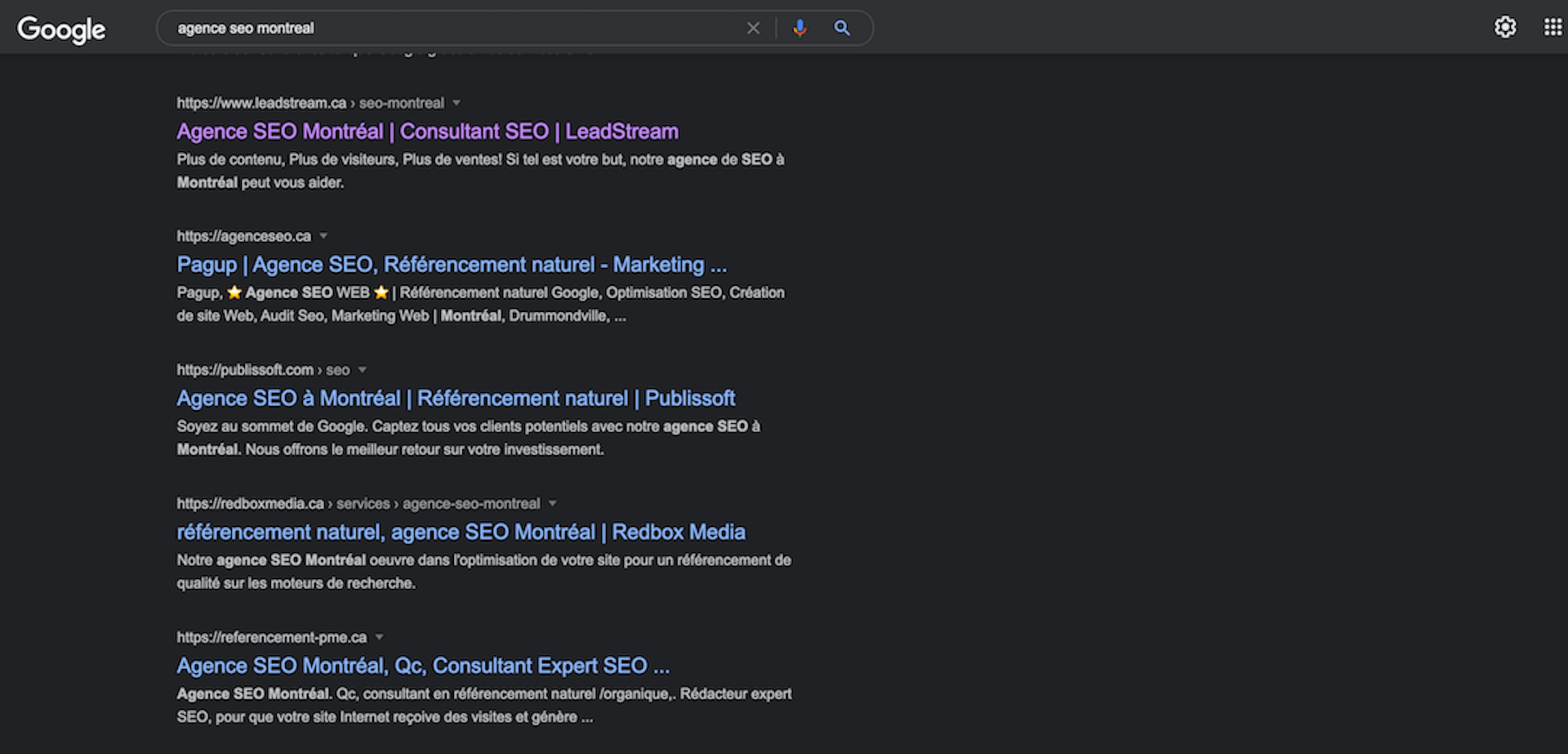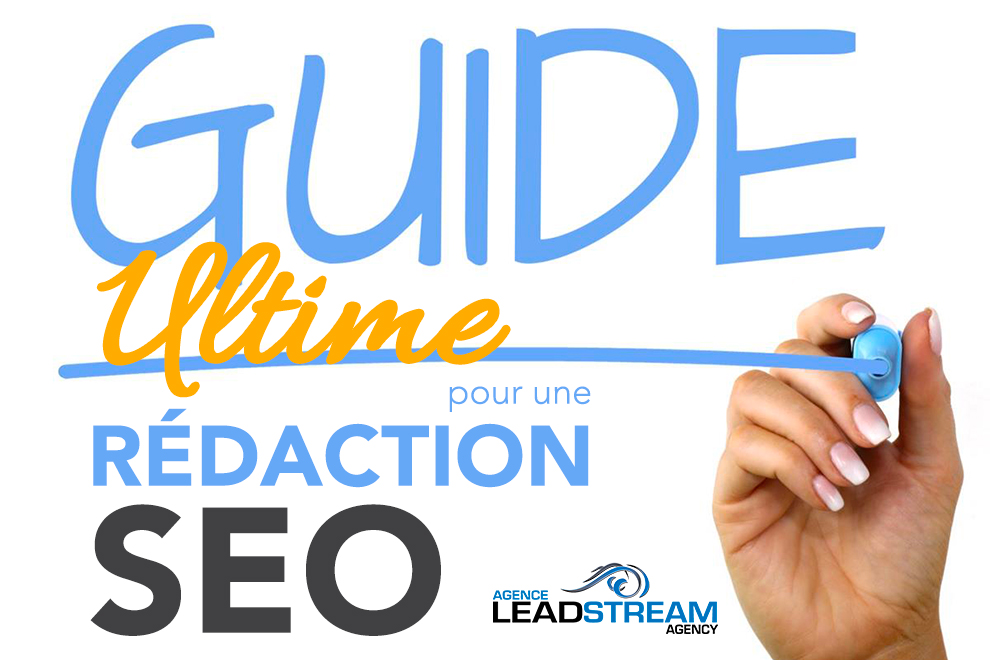How to write effective SEO content
Web presence is a great place to start, and a necessary step if you want your business to grow. However, in and of itself, being present does not suffice; you must also be visible! For this to happen, it is essential that you adopt efficient SEO writing strategies so that you are generating traffic towards your website and webpages.
LeadStream, an SEO agency in Montreal, gives you all the tips and tricks you need to create optimized texts that will easily be found through search engines. Learn more about SEO and how it works.
What is SEO content?
SEO stands for “Search Engine Optimization”. It can also be called “natural referencing”, since traffic is ‘naturally’ drawn towards your website, without you having to pay for it.
In this sense, it is the opposite of SEA (Search Engine Advertizing), which consists of paying for short term ads that serve towards referencing purposes. Generally speaking, SEO is much less costly for small and medium businesses, who often cannot afford to pay for Google Ads services.
When the goal is improving your position in search results in a durable way, the key to success is appealing to algorithms. This is where efficient SEO writing and content comes in. It aims at establishing strategies that ensure that your content appears at the top of search engine results.
The very first strategy, one that is at the heart of SEO writing, is utilizing and integrating appropriate keywords. In order for web users to find you easily, you must obviously use the very same words they will be typing into the search engines themselves.
These keywords might be typed into different search engines like Bing or Yahoo, but we are much more interested by Google algorithms. Why? Because Google’s presence currently represents no less than 91 % of the market.
Let’s come back to keywords: they are at very core of SEO strategy, but you must know that their impact is quite complex. Google algorithms have evolved, and now also recognize the quality of the web content itself and the user experience you offer. So, in order to create content that will be appreciated by Google, you must also create content that will appeal to users!
When used adequately, SEO writing and content can literally boost your business by increasing your online visibility.
How to go about SEO writing?
Are you ready to create optimized content but are unsure where to start? Yes, it is true that SEO writing can seem quite intimidating at first. Don’t panic! Here is a step-by-step guide that will allow you to get off on the right foot.


Searchin for keywords
Since keywords are at the very heart of SEO strategy, it is essential to use them properly. You must, of course, choose keywords that are directly related to your specific area of expertise and the content you wish to address. As a general rule, each online blog or article contains a main keyword, plus several secondary keywords.
The keywords you select must obviously be keywords that are actually being used by web users, or you will be working for nothing. Thankfully, several basic data analytics tools help you in this like, for example:
- Ubersuggest
- SEMrush
- Google Trend
- Keywords Everywhere
Your keywords can be long or short; they will then be referred to as being short-tail, medium-tail, or long-tail.
A short-tail keyword will generally include one to two words. This means it will probably refer to a very vast reality, which also translates into a very competitive reality. Good luck standing out in search engines with words like “car” or “shoe”!
These two examples are words with a high degree of difficulty. Ranking tools will measure these with a KD score (Keyword Difficulty). Keywords are ranked from 0 to 100; the higher the score, the more difficult it will be for you to stand out.
That is why it is important to spruce up your content with keywords that have a lower score, or medium-tail or long-tail keywords. These will include a minimum of 2-3 words, or sometimes lots more, and correspond to a much more precise search. Users who know exactly what they are looking for also have a higher conversion rate: which means they are much more susceptible of moving from visitor to actual client.
Let’s look at a concrete example. Let’s pretend you are a Toyota dealership. A short-tail keyword you could use would be, for example, “Toyota RAV4”. Things will get much more interesting for your SEO content if your keywords answer to more precise searches, while also remaining popular, like, for example:
- “Price for the 2022 Toyota RAV4”
- “Hybrid plug-in Toyota RAV4”
- “2022 Toyota RAV4 for sale in Montreal”
To find the right keywords, you must first know which keywords are more susceptible of attracting visitors to your website. It is obviously useless to try to answer questions that very little users actually ask themselves!
The tools mentioned above will allow you to identify proper keywords according to your target audience and search volume, regardless of if they are short or long-tail.
Semantics
In SEO strategy, semantics refer to the lexical field or, in other words, all of the terms or words related to a subject of theme. To make this clearer, let’s take the word “shoe”. The lexical field for “shoe” will include words like “leather”, “sole”, “boot”, “fit”, “lace or lacing” and several other terms.
What is important to keep in mind is that Google understands semantics more and more. The richer your lexical field is in relation to your own field or subject, the more Google bots will understand about it, the more users will be directed towards your content.
This means that things are changing, and that repeating your main keyword incessantly no longer does the trick. In order to get you at the top of search engine results, rich texts with quality content are much more efficient!
How do you improve your semantics? You must first properly identify your main keyword, and then its lexical field. Once again, specialized software can help you with this.
Moreover, internal linking is a great way to improve semantics. Internal links allow you to redirect visitors to other pages on your own platform through similar themes, which are related to the same subject.
Structure
Optimizing your search engine results is also done thanks to well-structured texts. Why? Simply because they help algorithms identify the subject easily, as well as offering a greater user experience.
First, you much establish an SEO title. This title will become your tag, which will identify your content in search engines. It will certainly include the main keyword you have previously selected and identified.
It is part of the Meta tags (or metadata), just like the Meta description. The Meta description is just as important: it summarizes a page’s content in the search engine result, right under the title of the page. The text must be clear, concise and unique, and work as a hook.
Let’s move on to the heart of the text, where different titles will appear. The first will be the main H1 title, where you will find the main keyword and a clearly identified subject. Then, the H2 will serve to divide paragraphs, while the H3 will allow you to subdivide these even further.
The amount of H2 and H3 will obviously depend on the subject you have chosen and the length of the text. You can sometimes subdivide further with H4, H5 and H6. Inversely, a shorter text could include H2 only.
One of the reasons to include several HN elements is to lighten up the text. Denser paragraphs or blocks of text will not attract readers, nor will it keep their attention. This is why you should always make paragraphs short.
Other elements can also be worth adding to the structure of the text in order to optimize the user experience. Readers often want to read quickly. Lists are a great way to present the information in a clear manner, by avoiding heavy blocks of text. Lists are the best way to enumerate as well.
For a quick and concise reading experience, tables are also another key structural element that are greatly appreciated by users. They are also a great tool for product comparison.
Good structure will allow you to optimize your SEO content and to facilitate the reading experience. A well-structured and light text will be much more enjoyable for the web user. Moreover, titles and subtitles will allow search engines to understand your text better, so it really is a win-win!
Targeting the proper audience
Before thinking of any type of content, it is essential to know who your target audience is. Who are you speaking to? What are they looking for?
In marketing, we refer to this as creating a persona; in other words, creating a semi-fictitious character that will allow you to identify your consumer’s needs better. A young student and a father will not necessarily have the same needs! Identifying your persona will not only allow you to adapt the content properly, but it will also give your text the right tone, or “voice”.
It is extremely important to determine exactly what your target audience is searching for. Are they looking for information? To make purchases? To compare products? The more relevant your content, the more you will be keeping the web users’ attention… as long as you know who they are!
Asking a marketing team for help is an excellent choice when it comes to answering all of these questions and putting all the chances on your side.
10 tips and tricks for efficient SEO content
Now that you have identified your target audience and essential keywords, the ball is in your court! You now have a good idea of SEO basics. But how do you go about writing a good article?
Florian, our LeadStream Agency SEO specialist in Montreal, gives you 10 tips and tricks to get off on the right foot.

1. Search for a good opportunity in Google suggestions
For quality SEO content, you must first find a good subject that will also give potential visitors the answers to what they are looking for. In order to do this, Google suggestions are an excellent tool!
Suggestions show up in the search box, but also at the bottom or in the middle of the results page. These are searches that are frequently typed in by web users. This means they are also an excellent opportunity for you to stand out!
You must filter, but also rely on your competitor’s authority in the field. These measures have been designed to indicate how strong a website is on a scale from 0 to 100, and also has a lot to do with referencing.
If, on any given subject, the websites on the first pages are considered to have a strong authority, it will be harder for you to fit in. Inversely, it would be a great opportunity for you to measure yourself up to competitors with a domain authority that is equal or lower to yours!
2. Find a subject that works as a hook

As previously mentioned, finding keywords is not enough; you must identify the search intentions behind the keywords. A subject will only work as a hook if its answers the questions behind these intentions.
To attract readers, you must also appeal to their curiosity. How do you do this? By asking them questions. Put yourself in their place. What questions do they ask themselves? What are their preoccupations, or problems?
Moreover, by asking the users questions, you make them want to discover the answer, which will hook them into reading further. For this to work, you must obviously know exactly who your target audience is!
If you are looking for a trendy subject that is currently at the peak of popularity in your field, softwares like Google Trends are really excellent tools.
3. Comparing your content with you competitors’ content
An efficient SEO strategy is one that will get you to show up at the top of the search engine results. This means you obviously need to offer better content than your competitors in order to come up first.
Go take a look at what kind of subjects they touch upon. You will have a better idea where you will want to be headed with your own website. Take notes on their keywords and use their ideas for inspiration, while avoiding all forms of plagiarism, of course.
Compare your content to that of your competitors and ask yourself what you might get out of it. Inversely, note what subjects they have never talked about: this will allow you to offer something new and fresh for your own readers.
Keep in mind that unique content will definitely appeal to algorithms, as well as to your readers. A duplicated content will do just the opposite, and will harm your results instead of help. It is important to inspire yourself from your competitors’ sites, but to add your own special touch. In other words, make it your own!
4. Get your inspiration from SERP results
Firstly, what is SERP? It simply stands for “Search Engine Result Page”, which refers to the very first page in search engine results.
If you want new traffic, it is crucial that your keywords lead you to popping up in this first page. It is a well-known fact: it is extremely rare that users actually make it to the content found on the second or third pages! Some studies have even shown that visitors most often only look at the first two or three results.
These first results are the highest ranking in natural referencing and those you want to surpass. To do better, you must first understand what you’re up against, don’t you? For this reason, it is essential that you do your research: take a look at the contents from these results and draw your inspiration from them.
Use them to find new long-tail keywords or to enhance your own content. Reading different texts can also inspire you to find a new and original angle to approach the subject in a way it hasn’t been done before!

5. Simple and rich content without mistakes or typos
Quality content really means texts that are rich with information. Do not forget that your readers are looking for information. They are not searching for a prose exercise or a poetry contest.
In order to keep their interest, the information must keep moving forward without being redundant. Long texts are great; but empty sentences are not! You should also avoid overly long sentences that make the text heavy. In other words, keep it simple and to the point.
To succeed in this, you will have to express yourself in a natural and concise manner. If your reader must read the sentence several time in order to understand it, there is a good chance he’ll give up reading. This happens often when sentences are too long.
The same thing will happen if he’s confronted with words he doesn’t know. As a general rule, you should choose simple words that are easy to understand by users. If you must introduce an unknown notion, take the time to define this notion within the text itself.
Vocabulary must be adapted to your target audience. While creating your persona, you will also have identified how much they know on this given subject. If you are addressing specialists in a given field, then technical terms can find their way into the text.
Your target audience’s education level will also have an influence over the type of vocabulary you can use. In every case, you should use words that are easily understood by your readers so as to keep with the idea of simplicity.
Finally, make sure there are no mistakes nor typos in your text. Content must be impeccable: it is a reflection of your image!
A text containing mistakes (spelling, grammar, syntax, etc.) will lead readers elsewhere, and quickly. Why? Simply because it will make you look less professional, and make them feel like you are not trustworthy.

6. Google robots reward good semantics
As previously mentioned, when it comes to SEO, semantics refers to the lexical field. This means it refers to word definitions and, on a more global scale, what your text is really about. The richer your text is in terms of semantics, the more easily understood it will be by Google.
Repeating a handful of keywords is not enough. It is important to create a lexical field around these words. In order to do so, you will have to find synonyms, and words that are closely related to, or have a similar meaning in a larger sense.
This can certainly represent a lot of work. Sometimes you know words but are not necessarily thinking of them. Once more, some tools have been developed specifically for this like, for example, TextOptimizer.
These tools will help you build a rich semantic field around your theme, and will help you enrich the quality of your SEO. A richer text is a sure step towards better referencing!

7. Use bold text (strong tags) to add power to important words
We have seen above that an easy and fluid read is an essential quality of SEO. On top of lists and tables, another graphic element that users like are bold texts.
Since online reading is not always linear, these elements allow the reader to easily find, within the text, information of interest. It is thus important to choose strategic words that hold a lot of meaning within the text itself.
Moreover, balance is key: if there is too much bold text, the words will lose their impact.
Good news: using strong tags (words in bold) also allows you to optimize your SEO performance! In fact, Google will recognize the importance of these words in your texts, which means they are doubly important, so choose them wisely!
Italics can also be used to attract the reader’s attention. However, it does nothing for your SEO. Bold text hits two birds with one stone, which means they are definitely more advantageous for you in reaching your goals.
8. Technical aspects to optimize your text
Writing a good text with properly selected keywords is great. Utilizing technical elements is even better! It is the final touch, allowing you to really optimize your online presence and create content that is truly performant in terms of SEO.
What exactly are these technical elements? They include several different things, some of which are invisible while reading like, for example, the metadata we referred to previously.
Google will use these technical aspects to evaluate if your content is relevant, to understand the hierarchy of the information and much more.
9. Internal linking, backlinks, HN tags, URL, titles, Metas
What exactly are these technical aspects and how to use them?
First and foremost, internal linking corresponds to the links that can be inserted into your own texts and that can serve as a bridge between one subject, and another related subject. This technique allows you to draw more clicks to your different webpages and to hold web users’ attention longer. With internal linking, you can show Google how relevant your content is.
The backlink works opposite internal linking; it works from the outside in. It brings users to a page on your website from a place outside of your website. When the amount of backlinks you have increases, your authority in the field also increases.
HTML tags are another technical element that is really appreciated by Google, who can easily recognize them and use them to analyse your content. Amongst these you will find:
- The title tag (the SEO title)
- HN tags (H1, H2, H3…)
- Strong tags (bold text)
- Meta tags (metadata)
Finally, your webpage’s URL can serve towards your SEO referencing. You must avoid automatically generated URLs at all costs, which are made of a random combination of letters and numbers: they bring you zero advantage.
Focus on your main keyword instead. Be clear and concise; avoid special characters and voilà!
10. Utilizing free SEO tools
Paying tools for SEO content are specially designed to give you more precise and performant results. Nevertheless, for a small business, this can be a massive amount of money that you simply cannot afford.
If that is the case, you can opt for free versions that are available online. You could try the following, for example:
- Seominion
- TextOptimizer
- Detailed SEO Extension
- Google Trends
- Ubersuggest
- A hyperlink generator
These tools will also allow you to understand SEO content better and how it works, before you move on to a paying version, if you wish to do so.
3 trade secrets: what not to do with your SEO!
Now that you have a better idea of what you need to do, you are just about ready to go! It is important to know, however, how not to fall into SEO traps. Here are our trade secrets that will guide you in the right direction.
1. Writing specifically for search engines, instead of users
Those who are just beginning will often think that it’s enough to use a few keywords repeatedly and voilà! You’ll automatically show up at the top of search engines results. What a mistake!
Even if you do everything in your power to please Google algorithms by using keywords, tags and internal links, all your efforts will be in vain if your texts are not appreciated by users! While it is true that keywords have long been the greatest tool for referencing, algorithms have greatly evolved since.
In fact, it takes into account the time users spend on your page and the amount of times they go back to your page. So, it is not only a question of how many clicks you get, but how long you keep their attention. This means that if visitors leave your site quickly, you will get results that are exactly the opposite of what you are looking for!
This means that the user experience has an important role to play in referencing: SEO and UX go hand in hand. It is essential to play both fields by offering optimized content that aims to please users, both in terms of content as well as form.
2. Do not focus on quantity, but on quality
This advice is just as valid for keywords as it is for the different webpages that are found throughout your website.
Just picture for a moment that you and another business both write an article on the same theme. With similar results in terms of popularity, clicks will be divided between both your pages, which means you will get less visitors; that is simple logic.
Now, picture the same scenario, but imagine this time that both these pages stem from your own website. This means you are broaching the same subject twice, with the same keywords, hoping to get more clicks. Both your pages are thus competing against each other and both get less visits.
This way, each page has less weight, which can only mean bad news for your referencing! This is what is referred to as keyword cannibalization.
In order to avoid this phenomenon, it is essential to focus on quality and not on quantity. In other words, it is preferable to create a few quality pages rather than several pages that compete against each other. The equation is simple: one search, one content.
Has the harm already been done? It is not too late. There is a way to fix it, for example, by fusing pages together, reworking internal links, etc.
3. Not answering the specific keyword search
Using keywords is not enough, they must be used effectively. It is not only important to identify words, it is essential to identify the intentions behind the search of those keywords.
For example, if a user is looking for “leather shoes”, he might be looking to purchase a pair. If, on the other hand, he is looking for “leather shoe maintenance”, he is probably looking for advice.
If you decide to aim for those keywords but do not give him the advice he is looking for or you do it without enough precision, the reader will leave your page quickly to go look for answers elsewhere. You texts must show your expertise and offer an added value.
When the reader leaves your page, he automatically lowers the bounce rate, which will influence your statistics negatively. Even if your page theoretically fulfills SEO requirements, it will have a lot of trouble remaining in the SERP.
So, when users type in a keyword, ask yourself what the intention behind the search really is. Then, offer relevant and detailed content that truly answers their needs.
With proper software and good advice, it is possible to create your own SEO content. You must, however, keep in mind that this represents an important work load. Asking marketing professionals for help, who can help you write and edit outstanding content, remains the most advantageous solution.
You must also include your SEO content as part of your marketing strategy. To find out more, check out our SEO marketing guide or contact us! By surrounding yourself with experts like those who are part of the LeadStream team, you are sure to have a winning combination!


